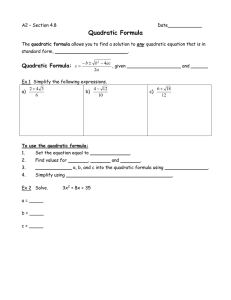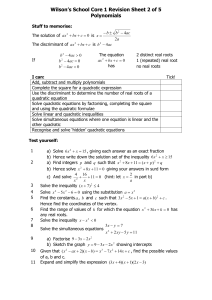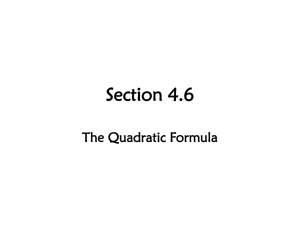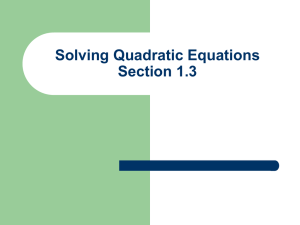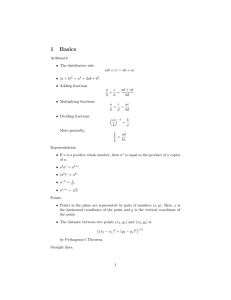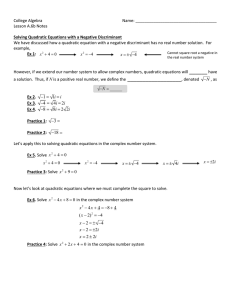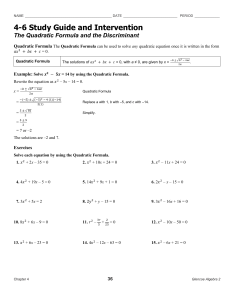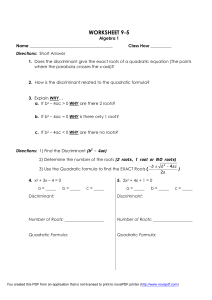Review of Algebra
advertisement
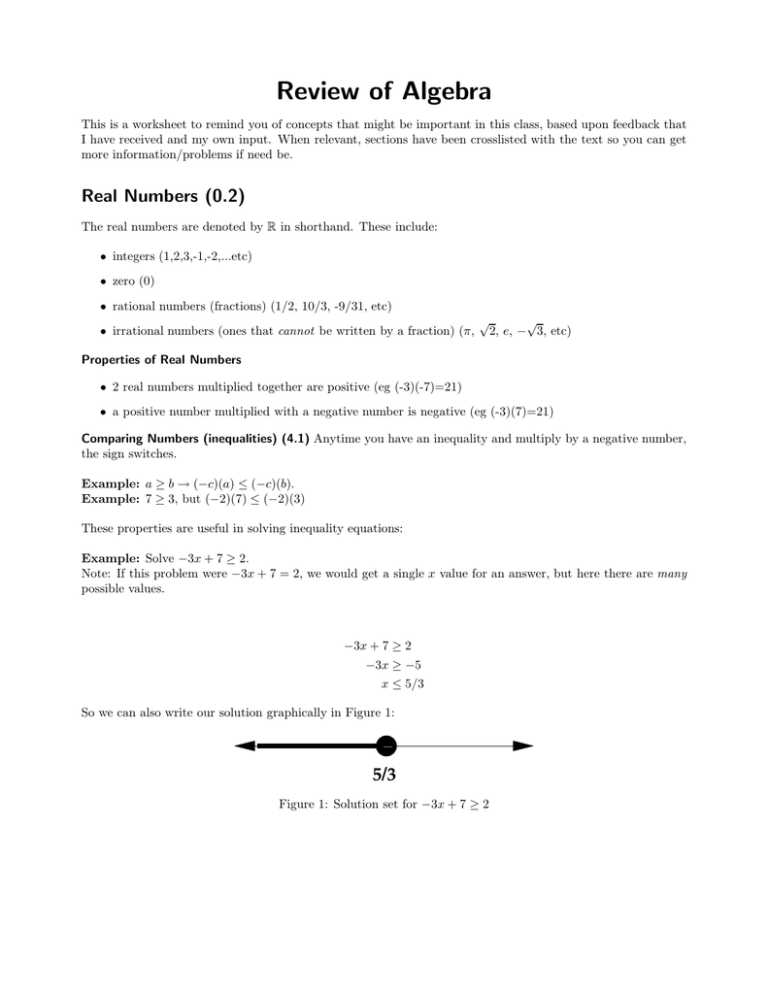
Review of Algebra This is a worksheet to remind you of concepts that might be important in this class, based upon feedback that I have received and my own input. When relevant, sections have been crosslisted with the text so you can get more information/problems if need be. Real Numbers (0.2) The real numbers are denoted by R in shorthand. These include: • integers (1,2,3,-1,-2,...etc) • zero (0) • rational numbers (fractions) (1/2, 10/3, -9/31, etc) • irrational numbers (ones that cannot be written by a fraction) (π, √ √ 2, e, − 3, etc) Properties of Real Numbers • 2 real numbers multiplied together are positive (eg (-3)(-7)=21) • a positive number multiplied with a negative number is negative (eg (-3)(7)=21) Comparing Numbers (inequalities) (4.1) Anytime you have an inequality and multiply by a negative number, the sign switches. Example: a ≥ b → (−c)(a) ≤ (−c)(b). Example: 7 ≥ 3, but (−2)(7) ≤ (−2)(3) These properties are useful in solving inequality equations: Example: Solve −3x + 7 ≥ 2. Note: If this problem were −3x + 7 = 2, we would get a single x value for an answer, but here there are many possible values. −3x + 7 ≥ 2 −3x ≥ −5 x ≤ 5/3 So we can also write our solution graphically in Figure 1: 1 0 0 1 5/3 Figure 1: Solution set for −3x + 7 ≥ 2 input x output f(x) f Figure 2: Schematic setup for a function Functions (1.2) You can think of a function as a box, that is you put in values x and you get values of f (x) out, shown in Figure 2: Two interesting questions are: 1. What values can we put in? (This is called the domain.) 2. What values can we get out? (This is called the range.) Usually finding the domain is more “interesting” than finding the range. To find the domain, you might have to resort to algebraic methods, and to find the range just plot the function on a calculator/computer. √ Example: What is the domain and range of f (x) = x? The domain will be all x ≥ 0. Recall that you cannot take the square root of a negative number. The range will be all R ≥ 0 √ Example: What is the domain of f (x) = x + 3? The domain is all x such that x + 3 ≥ 0. This implies that x ≥ −3. Example: What is the domain of f (x) = x/(x − 1)? The domain will be all R except x 6= 1. (The number a/0 is undefined, so here set the denominator equal to zero and solve for x.) In general, f (x) in the above example is called a rational function. Can you reason out why it has that name? As a result, whenever we have: f (x) = g(x) , h(x) where g(x) and h(x) are polynomial functions, the domain of f (x) will be everywhere except where h(x) = 0. Composition functions are of the form: f (x) = g (h(x)) , so in keeping with our “machine” analogy for functions, the schematic is in Figure 3 to find the domain of composition functions, simply take things step by step. √ Example: What is the domain of f (x) = x2 − 1? √ Identify g(y) = y and h(x) = x2 − 1. Verify that f (x) is indeed g(h(x)). The domain on h(x) is all of R, but since the domain of g(y) is all y ≥ 0, then domain of f (x) will be where the graph of h(x) is bigger than or equal to 0. Thus the domain of f (x) is x ≥ 1, x ≤ 1, or via the numberline in Figure 4. input x f=g( h(x) ) input x h g output f(x) The "circle" is all of f Figure 3: Schematic for a composition function Quadratic Functions (Chapter 2) These are functions of the form f (x) = ax2 + bx + c, where a 6= 0. The domain of quadratic functions is all of R. The vertex is at x = −b/2a, and for the y value, just plug in. An interesting question is what are the roots of f (x)? (Where f (x) = 0). You can approach this question 2 way: Method 1: Factoring The goal is to write ax2 + bx + c = 0 in the form of (x + e)(x + f ) = 0, where e and f are just numbers. If a 6= 1 in our quadratic equation, we can just divide our equation by a to put it in the form x2 + ab x + ac , but for simplicity, assume that we have an equation of the form where a = 1. Let’s multiply out (x + e)(x + f ) = x2 + (e + f )x + ef . Since we are forcing this to be equivalent to x2 + bx + c, then it must be that: e+f =b ef = c Solving these equations by “guess and check” gives the result we want. Example: Solve x2 + 5x + 6 = 0. Using the fact that: e+f =5 ef = 6 By guessing the factors of 6 (which are 1,2,3,6), we see that 2 × 3 = 6, 2 + 3 = 5, giving our factorization: -1 1 √ Figure 4: Domain for f (x) = x2 − 1 x2 + 5x + 6 = (x + 3)(x + 2) Setting this equal to 0 shows that x = −3, or x = −2. Usually after a lot of practice factoring you can do the factoring automatically in your head–that is perfectly all right, but if you get stuck it helps to remember the method to your madness... Method 2: Quadratic Formula If the factoring doesn’t work out, or you get stuck, this is a good formula to know and have in your “algebra toolkit”. The equation ax2 + bx + c = 0 has solutions: x= −b ± √ b2 − 4ac 2a The quantity b2 − 4ac is called the discriminant. When: • b2 − 4ac > 0, we have two roots • b2 − 4ac = 0, we have one root • b2 − 4ac < 0, we have no roots. Various cases for the discriminant and roots of quadratic functions are shown in Figure 5. discriminant > 0 discriminant = 0 Figure 5: Various cases of the discriminant discriminant < 0

